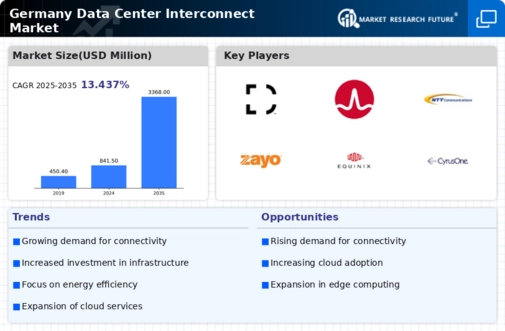Expansion of Data Center Infrastructure
The ongoing expansion of data center infrastructure in Germany is a pivotal driver for the market. As organizations increasingly migrate to digital platforms, the demand for robust data centers has surged. In 2025, the number of data centers in Germany is projected to increase by approximately 15%, reflecting a growing need for interconnectivity solutions. This expansion is not only driven by the need for enhanced data processing capabilities but also by the necessity for improved disaster recovery and business continuity strategies. Consequently, the data center-interconnect market is likely to experience significant growth as companies seek to establish reliable connections between their facilities, ensuring seamless data transfer and operational efficiency.
Rising Demand for Low Latency Solutions
The rising demand for low latency solutions is a crucial driver for the data center-interconnect market in Germany. As industries such as finance, gaming, and telecommunications increasingly rely on real-time data processing, the need for rapid data transmission has become paramount. In 2025, it is projected that the demand for low latency interconnect solutions will increase by 25%, reflecting the urgency for businesses to enhance their operational efficiency. This trend is particularly evident in sectors where milliseconds can impact performance and customer satisfaction. Consequently, the data center-interconnect market is likely to evolve, offering specialized solutions that cater to the needs of latency-sensitive applications, thereby ensuring competitive advantage for organizations.
Increased Focus on Hybrid IT Environments
The shift towards hybrid IT environments is a significant driver for the data center-interconnect market in Germany. Organizations are increasingly adopting a mix of on-premises and cloud-based solutions to optimize their IT operations. This trend is expected to continue, with approximately 60% of German companies planning to implement hybrid strategies by 2025. Such environments necessitate robust interconnect solutions to ensure seamless integration between various platforms. As a result, the data center-interconnect market is poised for growth, as businesses seek reliable and efficient connectivity options that facilitate data exchange across diverse infrastructures. This hybrid approach not only enhances operational flexibility but also supports scalability and innovation.
Regulatory Compliance and Data Sovereignty
Regulatory compliance and data sovereignty are critical factors influencing the data center-interconnect market in Germany. With stringent data protection laws such as the General Data Protection Regulation (GDPR), organizations are compelled to ensure that their data handling practices align with legal requirements. This has led to an increased focus on local data centers and interconnect solutions that facilitate compliance. In 2025, it is estimated that around 70% of German enterprises will prioritize data sovereignty in their IT strategies, thereby driving demand for interconnect services that support localized data management. As a result, the data center-interconnect market is expected to adapt to these regulatory pressures, offering tailored solutions that meet compliance standards.
Adoption of Advanced Networking Technologies
The adoption of advanced networking technologies is reshaping the landscape of the data center-interconnect market in Germany. Innovations such as Software-Defined Networking (SDN) and Network Functions Virtualization (NFV) are enabling more flexible and efficient interconnect solutions. In 2025, the market for SDN in Germany is anticipated to grow by 20%, indicating a shift towards more agile networking infrastructures. These technologies allow for dynamic resource allocation and improved bandwidth management, which are essential for meeting the increasing demands of data traffic. Consequently, the data center-interconnect market is likely to benefit from this technological evolution, as organizations seek to enhance their connectivity capabilities and optimize their network performance.




















Leave a Comment